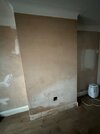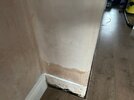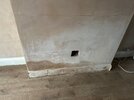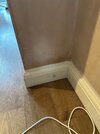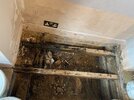What's the mods " not appropriate" comment about tell ? do you want a thanks from poster #13 . perhaps a Valentines card ?OP,
You say: "Any help greatly appreciated" I gave you "help" but you dont even take the trouble to reply to my post?
You are using an out of date browser. It may not display this or other websites correctly.
You should upgrade or use an alternative browser.
You should upgrade or use an alternative browser.
Damp showing in Chimney breast
- Thread starter icon_boy
- Start date
OP,
No cavity is indicated in your text or pics - because, as you say, the back wall is a party wall.
The "vent in the room above" is ventilating a different flue ie. the bedroom fireplace flue.
Flues only serve one fireplace - c/breast's might carry a number of flues.
Besides the flue there is the possibility that there is a fender wall with a soil filled "hearth" that could create rising damp conditions.
No cavity is indicated in your text or pics - because, as you say, the back wall is a party wall.
The "vent in the room above" is ventilating a different flue ie. the bedroom fireplace flue.
Flues only serve one fireplace - c/breast's might carry a number of flues.
Besides the flue there is the possibility that there is a fender wall with a soil filled "hearth" that could create rising damp conditions.
Once a masonry base stabilises itself, paint finish and permeability becomes less important. On fresh plaster, and for up to a year afterwards, permeable paint is recommended. Trade paint is the best option - it's called trade paint because it is specifically formulated for use on new plaster.
PS. this would be different if the base was susceptible to dampness - but that chimney looks pretty dry. The apparent dampness is coming from the air, not from the base.
With all due respect, I think you may have meant contract paint and not trade paints. Contract matt emulsions tend to have lower levels of vinyl and will not blister if the plaster is still slightly damp (given that they don't create a moisture barrier. The lower levels of vinyl/acrylic however mean that they are harder to keep clean. In many cases they are used by decorators that simply want to work with a very low sheen paint which can be slapped on far more quickly, and which are cheaper to purchase.
I seldom ever use contract paints, I ask the customer to call me in once the plaster had dried. In the case of plaster over plasterboard it may be less than a week. I apply a (5:1) dilute coat of Dulux Trade matt emulsion, often followed by a wet on wet coat, and then 2 full fat coats.
I suspect that you are talking about back to the brick plastering rather than plasterboard. Again I wait until the plaster coats are a uniform colour. Depending on the time of year, thickness and airflow, I would expect to be able to paint over in up to 4 weeks. In the absence of water ingress, I have never had an issue using Trade rather than contract matt emulsion in 30+ years.
Conversely, I have had loads of problems painting over contract paints with the better quality trade paints. I normally have to thin the first coat of trade paint to deal with the level of suction.
I would add that pretty much every job has been gypsum plaster and appreciate that the advice for lime plaster may be different, and am mindful of the fact that you were discussing lime plaster earlier. I just wanted to add, for the benefit of others with gypsum plaster, that they can use use any paint they want once the plaster has dried. I have used waterbased eggshell over plaster on back to the brick plaster within 4weeks of the skim coat being applied, again no problems.
The vast majority of buildings that I work in are in West London, they are 9 inch walls (no cavity), often red rubbers at the front exterior, yellow stock internally and at the sides and back. Absent of a failed DPC, poor pointing or guttering/roofing faults, I seldom have problems with paint choices.
Do things vary depending on the geographical location/building materials that much?
So there was no rain overnight, and perhaps a light drizzle in the early hours. I was just looking at the chimney breast, and it looks noticeably worse than it did yesterday and on Monday (when I took the original pictures).
I've booked in a plasterer to hack back to brick and then build up with Limelite Renovating Plaster and then skim with Limelite High Impact Finishing Plaster.
Good video here -
I've booked in a plasterer to hack back to brick and then build up with Limelite Renovating Plaster and then skim with Limelite High Impact Finishing Plaster.
Good video here -
Attachments
Good shout, about looking at other side, never noticed that area before up until now.It would be very useful to look under the floor.
And some photos of the other side of the wall.
Getting to the floorboards is going to be a pity, due to the laminate flooring, with the subfloor running perpendicular too...
We had these out a couple of months ago, and I did not notice any water at the hearth.
Attachments
I wouldn't be surpised if water is soaking up the rubble under the hearthstone. It goes down to the original footings. There will be no DPM. You can break it up and dig it out. As well as removing the path, exposing the bare brick allows water to evaporate off. You may also discover a source of water down there.
I wouldn't be surpised if water is soaking up the rubble under the hearthstone. It goes down to the original footings. There will be no DPM. You can break it up and dig it out. As well as removing the path, exposing the bare brick allows water to evaporate off. You may also discover a source of water down there.
Thats a massive job, could I not use something like Dryrod Damp Proofing Rods DPC Kit
Drill and insert these rods at the base of the breast (where the flooring meets not below the subfloor), then not having to rip out the flooring?
OP,
Without permission, how would you follow the above suggestion to inspect your neighbour's chimney breast & living room wall?
Just one look & your pics make clear that there is no "hearthstone" - neither is "water soaking up the rubble" under a non-existing hearthstone.
Moisture in the enclosed soil rises by capillary action ie. rising damp.
But you have no need to be lifting any flooring unless its damaged or swollen. Carry on with the Limelite - & sweeping the flues.
Without permission, how would you follow the above suggestion to inspect your neighbour's chimney breast & living room wall?
Just one look & your pics make clear that there is no "hearthstone" - neither is "water soaking up the rubble" under a non-existing hearthstone.
Moisture in the enclosed soil rises by capillary action ie. rising damp.
But you have no need to be lifting any flooring unless its damaged or swollen. Carry on with the Limelite - & sweeping the flues.
Thats a massive job, could I not use something like Dryrod Damp Proofing Rods DPC Kit
Please excuse my uproarious laughter.
But, no.
Use your imagination tell, a hearthstone could be there under the laminate. No frenzy from me , no surprise either @ your response. Perhaps the OP could seek his neighbours permission ? Does your mom give you permission to write your trite ripostes on Diynot ?OP,
Without permission, how would you follow the above suggestion to inspect your neighbour's chimney breast & living room wall?
Just one look & your pics make clear that there is no "hearthstone" - neither is "water soaking up the rubble" under a non-existing hearthstone.
Moisture in the enclosed soil rises by capillary action ie. rising damp.
Last edited:
DIYnot Local
Staff member
If you need to find a tradesperson to get your job done, please try our local search below, or if you are doing it yourself you can find suppliers local to you.
Select the supplier or trade you require, enter your location to begin your search.
Please select a service and enter a location to continue...
Are you a trade or supplier? You can create your listing free at DIYnot Local


